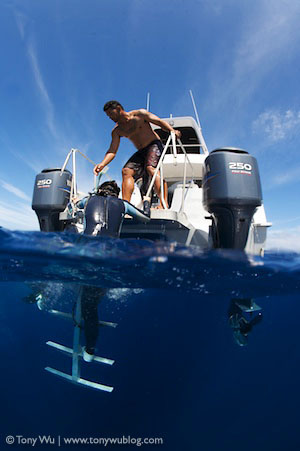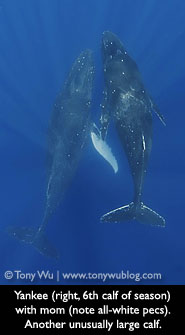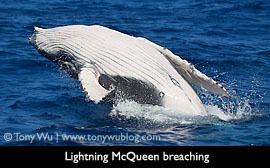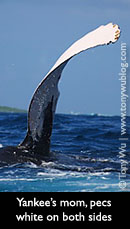 It's been quite a week, starting off with awful weather, followed by some of the best weather of the season, then by foul conditions again...talk about volatility. Fortunately, however, the best weather coincided with the days I was out on the water, while the worst fell on the days I was land-bound...talk about good timing!
It's been quite a week, starting off with awful weather, followed by some of the best weather of the season, then by foul conditions again...talk about volatility. Fortunately, however, the best weather coincided with the days I was out on the water, while the worst fell on the days I was land-bound...talk about good timing!
Besides the volatile climate, this week stands out for the number of new calfs we were able to ID, a total of nine, which is three times the total number of calfs we've ID-ed before this week...though we cheated a bit, as I'll explain below.
Blame it on the Weatherman
I generally can't get out on the water on weekends, because of the travel schedule that my friends from Japan have to follow. Their flights bring them into Tonga on Monday, and out on Saturday, which means I'm occupied those days sorting things out.
By law, all commercial activity is prohibited on Sundays, so Sunday is the day we usually set aside for recovery. The Sunday prohibition hasn't been enforced with much vigor this year though, so boats do seem able go out for the time being.
 As it turns out, however, the conditions have been bad both last weekend and this weekend. Last Saturday, it was windy and rained in the late afternoon through to Sunday morning. The rain cleared up on Sunday, but the winds were still high, and it was cloudy and drizzly all day long.
As it turns out, however, the conditions have been bad both last weekend and this weekend. Last Saturday, it was windy and rained in the late afternoon through to Sunday morning. The rain cleared up on Sunday, but the winds were still high, and it was cloudy and drizzly all day long.
After a nice spell of weather at the beginning of the week, a big rainstorm hit on Wednesday evening, and the weather really deteriorated again this week on Friday. We were out on the water, getting beaten up by 20+ knot winds, criss-crossing chop, whitecaps, tall swells and occasional cold, pelting rain. Not nice.
As I started writing this on Saturday, conditions aren't much better, with the weather forecast projecting at least a day or two more of the same. (As of Monday morning, nothing's changed.)
It is, of course, possible to go look for whales when it's dark, grey and raining. It's the winds that really make things difficult though, especially if you're in a small speedboat. Within a few minutes, you feel both shaken and stirred, with a good measure of scrambled tossed in. The splash and spray kicked up by the winds gets in your eyes. It's difficult to see your hand in front of your face, much less detect the subtle nuances of whale breath.
To cut to the chase...I'm perfectly happy to stay land-bound when conditions are really rough. (Note to Bart: I know...I'm a wuss, but right now, I'm a warm, dry, happy wuss.)

Baby Boom
Before the rainstorm hit Wednesday evening, we had some of the best conditions we've had this season...during Tuesday and Wednesday, there were generally clear skies, low winds and flat seas for much of the time. Everyone took advantage of the situation to travel farther than possible under normal conditions, and I'm pretty sure that most of the boats had great days to start the week.
I'm not certain if the nice weather had anything to do with it, but starting Tuesday, we had a sudden increase in the number of calfs we ID-ed.
On Tuesday, we found one new calf. Wednesday, there were five. Thursday, two, Friday one. This brings the total we've ID-ed to 12 this season. Keep in mind that we've seen more than we've ID-ed, so there are almost certainly more around. We don't count the calfs unless we get photos and/ or video good enough to ID them again.
The names we've given the calfs (with dates and place we first ID-ed them) so far are:
1st calf: Scratches (20 August, between Mounu and Sisia), named for the unique scratch patterns on its mother's fluke
2nd calf: White Stripe (21 August, near Lua), named for the white stripes on the dorsal side of its posterior region, between the dorsal fin and tail
3rd calf: Scar (21 August, next to Ovaka, also 5 August near Euakafa, but not clearly ID-able at the time), named for the two vertical scars on its right side, just posterior and dorsal to its pectoral fin
4th calf: Buzz (26 August, near Richards Patches), named b/c Takaji likes Buzz Lightyear, distinguished by mom's two white patches on right side, and scratches on right pec
5th calf: Blade (27 August, near Maninita), named for its distinct, sharp, white-edged dorsal fin
6th calf: Yankee (27 August, near Maninita), named for its mom, who was all black with all white pectoral fins, the classic northern-hemisphere look
7th calf: Tiny (27 August, near Luahiapo), named for its small size compared to the other calfs I found on the same day
8th calf: Onbu-chan (27 August, at Toku Island), named for its tendency to position itself on mom's back (Onbu in Japanese means piggy-back)
9th calf: ET (27 August, at Toku Island), named for the alien-like appearance of the escort (possibly a hybrid of two species?)
10th calf: Hokuto (28 August, next to Kitu), named for single spot on left side of body (Hokuto means North Star in Japanese)
11th calf: Lightning McQueen (28 August, near Maninita), named for the lightning-bolt-like white scar or birthmark under the right side of its dorsal fin
12th calf: Chico (29 August, near Swallows Cave), named for one of the women who was on the boat when it was found, easily identified by the whitish pectorals of both mom and baby
Besides the leap in numbers, there were a few interesting/ unusual things associated with these calf sightings.
 The Bell Curve: Around this time in the season, I'd generally expect to see a range of small- and medium-sized calfs. Since I've started visiting Vava'u regularly, calf births seem to have commenced each season in early July or so, and continued through September or so.
The Bell Curve: Around this time in the season, I'd generally expect to see a range of small- and medium-sized calfs. Since I've started visiting Vava'u regularly, calf births seem to have commenced each season in early July or so, and continued through September or so.
By late August then, the earliest calfs should be medium-sized, with another one-two months at least of growth to go before they're big and strong enough to attempt the journey down to Antarctica to the summer feeding grounds.
Picture if you will a bell curve, with the initial portion of the bell curve representing early calf births say toward the beginning of July, a steep slope representing more births in August/ September, and the tail end of the curve representing late births. This is how I imagined the birth rates to be, though obviously in real life, the number of births would likely be clumped around the full moon and possibly new moon.
Last season, there were no confirmed calf sightings (photo/ video) until around August 4 or 5 (which of course, doesn't necessarily mean that there weren't any calfs), when we found Hina Hina, a beautiful, friendly, largely whitish-grey calf. Other small calfs started appearing thereafter, so it seemed that the calfs were being born later than normal last year...in other words, it seemed like the bell curve was shifted by a month or so to the right (i.e., later in time).
 When I arrived in Tonga at the beginning of August this year, there were credible reports of something on the order of four calfs sighted already. I didn't see any photos, but the people (two independent sources) who told me about the calfs have sufficient experience and knowledge to distinguish calfs from other whales.
When I arrived in Tonga at the beginning of August this year, there were credible reports of something on the order of four calfs sighted already. I didn't see any photos, but the people (two independent sources) who told me about the calfs have sufficient experience and knowledge to distinguish calfs from other whales.
We haven't seen many calfs since then, which had me a bit worried...one, because having fewer calfs than normal isn't a good thing for the humpbacks, and two, because many of my friends and other visitors specifically wanted to see baby whales.
After this week, I think I may have a plausible partial explanation for why we haven't found many calfs until recently.
Blade and Yankee (calfs five and six) were huge...so large, in fact, that I initially mistook them for juvenile/ sub-adults until watching their behaviour for a few minutes. The calfs are unusually large for this time in the season. Actually, even if I saw these in mid-September, I would've been a bit shocked by their size.
I can't tell how old they are, but there are two possibilities I can think of to explain their size: They could be calfs from last year, or they could've been born really early this year, perhaps before July.
Either circumstance could help explain why the calf count seems to be lower this year than at any other time since I've started coming here regularly. If the calfs were from last year, the moms obviously wouldn't be in a position to give birth again this year, and if the calfs were born early, then they may have been large enough by the time I arrived in August to go farther out from the islands more often than a little tyke could, which means fewer sightings.
 In fact, I found both Blade and Yankee far, far from land, in an area that we can only visit when conditions are really good. They were both near the island of Maninita, which is the last, most southern major island in the Vava'u chain. Blade and mom were playing with spinner dolphins when we found them. And for a moment, I think Blade + mom crossed paths/ joined up with Yankee + mom + escort (that's how we found Yankee). I've never seen or heard of two calfs together, so assuming we observed correctly (difficult to be 100% sure when you're not underwater), this would be a first for me.
In fact, I found both Blade and Yankee far, far from land, in an area that we can only visit when conditions are really good. They were both near the island of Maninita, which is the last, most southern major island in the Vava'u chain. Blade and mom were playing with spinner dolphins when we found them. And for a moment, I think Blade + mom crossed paths/ joined up with Yankee + mom + escort (that's how we found Yankee). I've never seen or heard of two calfs together, so assuming we observed correctly (difficult to be 100% sure when you're not underwater), this would be a first for me.
In my Week One summary, I wrote about an encounter with another large calf, which I assumed was a calf from last year. I wasn't able to get a good photo of that calf, so I can't compare against the photos of Blade and Yankee, but for argument's sake, I'm assuming it was a third large calf.
Takaji also saw another large calf sometime during our second week here, which may have been a fourth.
I'm not sure which possibility (last year's calfs vs. early births this year) is more likely, but for now, I'm leaning toward early births this year. The calfs were large, but I'm not sure if they were large enough to have already made it down to Antarctica and back. Also, in spite of their size, their behaviour in the water was very baby-like.
Clearly, this is just a guess which could easily be wrong, but if this were the case, it could mean that the bell curve shifted to the left (i.e., earlier in time) somewhat this year. Of course, another possibility is that early births take place every year, but few people have noticed because there aren't many tourists around looking for whales in May or June. It is, in fact, quite difficult to distinguish the big calfs from juveniles/ sub-adults already separated from their mommies, unless you look really close and know what you're looking for.
Anyone have any insight as to how it might be possible to figure this out?
Location and Total Numbers: Five of the calfs we spotted were far away from the main Vava'u islands. Blade, Yankee and Tiny were far south, while Onbu-chan and ET were at a small island called Toku that's approximately 40km north of Vava'u.
Some people have speculated that fewer calfs are being found within the main island areas because of increased boat traffic and other human activity. It's certainly a possibility. But in the peak calf years of 2004-2006, there was at least as much, if not more boat traffic than now. Maybe there's a time delay, and the whales have decided to move farther away each year, or perhaps it's not a factor at all.
If a significant proportion of calfs were born slightly earlier than normal, then it might help explain why the calfs are farther out. Or perhaps, as I speculated previously, there are just areas that are "in vogue" in some years and not in others.
 In any case, this year is the first time we've been able to visit Toku due to its distance, so to have a whales-to-whales comparison, we should remove Onbu-chan and ET from our list. That would bring the total down to ten calfs this year that we've ID-ed around Vava'u.
In any case, this year is the first time we've been able to visit Toku due to its distance, so to have a whales-to-whales comparison, we should remove Onbu-chan and ET from our list. That would bring the total down to ten calfs this year that we've ID-ed around Vava'u.
If the large calfs (Blade and Yankee) are from last year, we'd need to subtract those too, leaving us with eight confirmed calfs.
By comparison, we ended the season last year at around this time with 13-14 calfs confirmed by the time I left on 1 September, so on a whales-to-whales basis, our count is lower this year than last.
We're staying two weeks longer in Vava'u this year than last, so we may yet be able to ID more calfs, though if we do, we'd have to take into consideration the extended observation period.
 Northern Look: Any way you look at her, Yankee's mom has the classic northern-hemisphere humpback look...all-black body, all-white pectoral fins.
Northern Look: Any way you look at her, Yankee's mom has the classic northern-hemisphere humpback look...all-black body, all-white pectoral fins.
Besides Yankee's mom, I've spotted two more northern-ish whales this year (males in a heat run) and Takaji has photographed one, which was sitting by itself half-way between Vava'u and Toku.
I've been comparing the white pecs with other shots of similar northern-looking whales in past years, but no match so far. Hopefully I'll get lucky at some point and get a match, either here, or from someone else's photos elsewhere.
I'm still fascinated by the possibility of humpbacks crossing the equator, however unlikely that may seem.
Possible Hybrid: The escort associated with ET looks strange. The body is too long. The snout is too short. It looks, in fact, like a cross between a humpback and another baleen whale, possibly a blue or sei.
We heard through feedback from our community of friends in Japan that there are eight documented cases of humpback/ blue whale hybrids.
It's impossible to be sure whether ET's escort is a hybrid or not just from a photo, but it sure looks that way.
Anyone else have information on this intriguing possibility?

Singing Escort: Buzz and mom had three escorts associated with them, one of which was blowing bubbles continuously, though not in an obviously aggressive manner (see my discussion about nuance from my Week Two summary).
(As an side, Takaji just noticed that in all the photos he has of whales blowing bubbles underwater, the whales are blowing bubbles from a single nostril only. They have two nostrils that look much like a human nose. I don't know the reason for blowing bubbles from a single nostril only, but I'll have to go back and check my photos to see if it's the same.)
This in itself was very interesting, but even more unusual was the fact that one of the escorts was vocalising as it was swimming.
 I've seen singers swim and sing as they approach the tail end of their singing cycle, but it's usually just for a brief period prior to surfacing for air.
I've seen singers swim and sing as they approach the tail end of their singing cycle, but it's usually just for a brief period prior to surfacing for air.
In this case, Buzz, mom and three escorts were swimming for extended periods, and one of the males was singing...or at least, it was emitting singing-like sounds.
I don't have photos, but we have video with audio that clearly shows this. I'm not certain to what extent singing (or vocalising) while swimming has been documented, but this is certainly the first time I've seen it, and everyone I've mentioned it to here has been surprised.
Anyone know if this has been documented previously? Can someone google this for me to check? My bandwidth here is limited.
Chuck
Being in Tonga isn't just about whales of course. This past week, Chuck Nicklin arrived in Tonga with his wife Roz and a group of travellers primarily from the US. I first met Chuck at Kasawari Lembeh Resort in Lembeh, where we crossed paths for a few days and had a great time diving together. (Incidentally, Chuck is headed there again after Tonga, and I'm going back in March 2009.)
 Chuck and his group had impeccable timing, with their first day on the water being Wednesday, when we had some of the best conditions we've had all season.
Chuck and his group had impeccable timing, with their first day on the water being Wednesday, when we had some of the best conditions we've had all season.
When I cruised by their boat at a distance, I could see they were having a terrific encounter, which I confirmed later when I chatted with the group briefly during breakfast the following day. It was great seeing so much enthusiasm and happiness in his group!
The world is a surprisingly small place, and crossing paths with great people like Chuck, Roz and their fellow travellers is one of the perks of doing what I do.
David
On a less positive note, there's a large coral formation near Swallows Cave that I visit every year when we snorkel near and around the cave. Usually, we do this toward the end of each group's trip, after everyone's had their fill of cetacean encounters.
The cave is beautiful, especially with warm afternoon light. Years ago, there were literally thousands of fish in the cave, which made for quite a spectacle if you dived down a few metres and swam back up through the swarms of fish.
A couple of years back, the fish all disappeared. Whether they left voluntarily or someone fished them out...no one knows.

Anyway, somebody named David decided to carve his name into the coral. When I visited the week before last, the coral hadn't yet been defaced, so this happened recently.
The coral isn't too deep, but you'd probably need to be on scuba to hold still long enough to carve your name into the coral, so basically, we're looking at a diver who decided to leave his mark.
Nice going David. You ^#*$@*$!
Next Year
Four weeks down, two weeks to go. I have to admit, I'm exhausted...but of course, I'm enjoying every minute, and I'm learning a lot.
At this stage, we're starting to plan for next year. I'm thinking of four to six weeks next year, probably around the same time period again, during August and September.
Next season, I'm planning to continue our exploration a bit further afield and spend more time in areas that other people don't visit.
There are a bunch of people who've written to me in the past to ask about trips to Tonga. Unfortunately, I've misplaced nearly all the relevant emails.
If you'd like to visit Vava'u next year with me, please let me know now so I can try to plan accordingly. I have to lock-in boats and schedules before I leave Tonga, which means not a lot of flexibility thereafter.